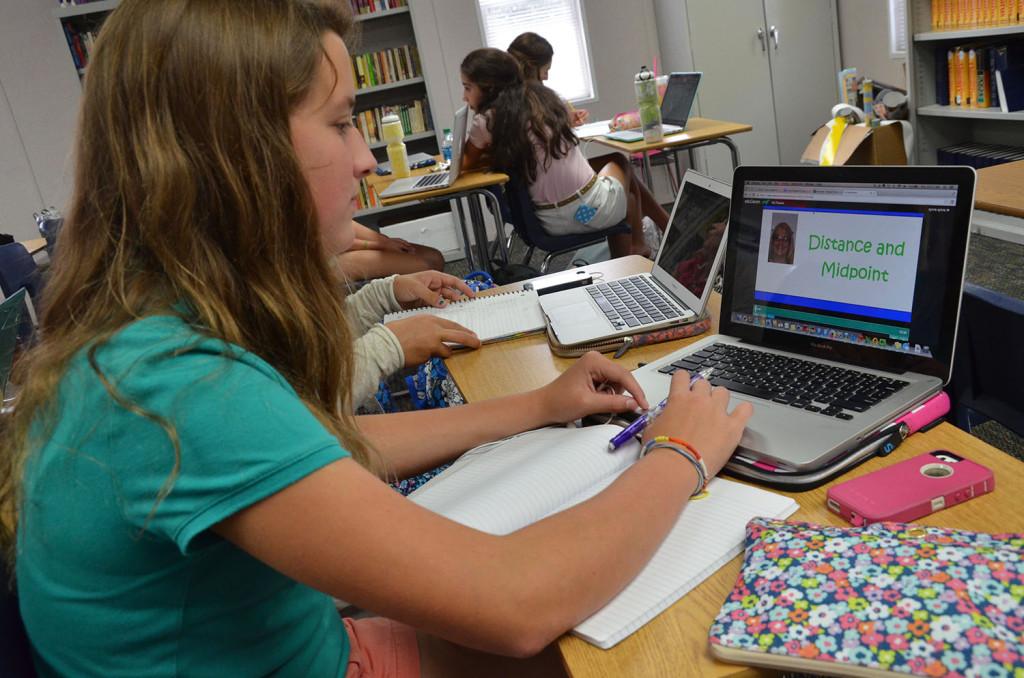Flipped learning, also known as the flipped classroom model, is the latest phenomena to turn Trinity Prep on its heels. On Oct. 1, several teachers took the plunge on National Flipped Day.
Instead of orally delivering the content in the classroom, teachers created recordings of their lessons ahead of time. Students learn the material at home and further their knowledge of the topic in class.
The evolution from a teacher-centered learning environment to a student-centered one marks the difference between a flipped and traditional classrooms. Students are able to learn at their own pace.
Traditional learning has created students who give standardized responses and memorize information, according to Pre-Algebra teacher Jennifer Baselice. Baselice also says flipped classrooms use class time more efficiently. She utilizes the method frequently in her class.
“The flipped classroom is a model where the direct instruction takes place outside of the regularly scheduled face-to-face classroom time,” Baselice said.
This allows students to learn the material at home, and then the teacher can help them with the concepts they did not understand during class time.
“This does not mean students don’t have homework,” Baselice said.
This method puts the ownership of the learning process into the hands of the students.
Flipped classrooms also look different than traditional classrooms.
Algebra I teacher Lynn Wilbur, a self-proclaimed ‘dabbler’ in flipped learning, says the difference is that the teacher would not be standing in the front of the room.
Rather, she considers her class more of a blended classroom than a traditional classroom because she still applies techniques she used during National Flipped Day.
Student reactions to the program are mostly positive. The students enjoy how the teacher interacts with them and helps them learn.
“I enjoy applying what I learned at home to the problems in class. It really helps me understand math,” said 6th grader Maneesh Rajulapati.
Teachers are not without their own doubts. Honors Chemistry teacher Carrie Lopez says the traditional method shines when it comes to a science oriented course like Honors Chemistry.
“I still think in a class like Honors Chemistry that students need me in front of them teaching so they can ask questions and I can give instant feedback. I will still continue to use [the flipped model] as a review for tests though,” Lopez said.
Popular software used to employ this style of learning include Screencast-o-matic, ThingLink and Kahoot.
“It’s very visual and allows me to give [the students] videos, text, links and images in an organized fashion. I have opened up chat rooms using Today’s Meet before tests so the students can ask any last minute questions. Once I flip more often, I will open the chat room the night the students are supposed to be working on the flipped lesson,” said Wilbur.
Google Hangout is another effective tool to video chat and discuss classwork and assignments. These programs contribute to creating this unique, upside-down learning system.
This new way of instruction has peaked student interest. The reinforcement of knowledge helps students learn.
Furthermore, the flipped classroom model takes pressure off of teachers. These flipped classrooms are slowly eclipsing the worn-out traditional methods of teaching.
“A flipped model can help reduce (not eliminate) those questions and allow the students to answer their own questions given the fabulous resources provided by their teacher,” Baselice said. “Then, our face-to-face time together is truly valuable and student-centered.”
Students are able to participate creatively in school without being bored..
“Flipping is not homework in class every day! Flipping is not study hall. It shifts the learning to the students,” said Baselice.




